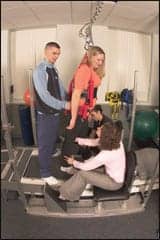One of the study’s participants is learning to use an avatar to walk in virtual reality. (photo courtesy of AASDAP/ Lente Viva Filmes)
Using brain-machine interfaces, including a virtual reality system that mimics leg control via a patient’s brain activity, helped eight paraplegics regain some sensation and muscle control, suggest researchers in a recent study.
The research, published recently in Scientific Reports, was led by Duke University neuroscientist Miguel Nicolelis, MD, PhD, as part of the Walk Again Project in São Paulo, Brazil.
Eight patients who had spent years paralyzed from spinal cord injuries participated in the study. The researchers report that the eight participants regained partial sensation and muscle control in their lower limbs after training with brain-controlled robotics, according to a media release from Duke Health.
“We couldn’t have predicted this surprising clinical outcome when we began the project,” says Nicolelis, co-director of the Duke Center for Neuroengineering who is originally from Brazil, in the release.
“What we’re showing in this paper is that patients who used a brain-machine interface for a long period of time experienced improvements in motor behavior, tactile sensations, and visceral functions below the level of the spinal cord injury,” he notes. “Until now, nobody has seen recovery of these functions in a patient so many years after being diagnosed with complete paralysis.”
Several patients saw changes after 7 months of training. After a year, four patients’ sensation and muscle control changed significantly enough that doctors upgraded their diagnoses from complete to partial paralysis.
Most patients saw improvements in their bladder control and bowel function, reducing their reliance on laxatives and catheters, and reducing their risk of infections, the release continues.
In the study, the eight patients first learned how to operate their own avatar, or digital likeness, in a virtual reality environment. Then, they wore fitted caps lined with electrodes to record their brain activity. Over time, the researchers began to observe the brain activity they expected to see when the patients thought about moving a particular limb, such as a leg.
“Basically, the training reinserted the representation of lower limbs into the patients’ brains,” Nicolelis states in the release.
As the patients progressed, they graduated from virtual reality to equipment that required more control over their posture, balance, and ability to use their upper limbs, such as the ZeroG and Lokomat walking devices. They also used robotic systems such as exoskeletons.
During much of their training, the release explains, the patients also wore a sleeve equipped with touch-technology called haptic feedback to enrich the experience and train their brains.
“The tactile feedback is synchronized, and the patient’s brain creates a feeling that they are walking by themselves, not with the assistance of devices,” Nicolelis shares in the release. “It induces an illusion that they are feeling and moving their legs. Our theory is that by doing this, we induced plasticity not only at the cortical level, but also at the spinal cord.”
Nearly all of the patients in the study have continued their rehabilitation, which now exceeds 2 years of training, per the release.
[Source(s): Duke Health, Newswise]





Pease provide details for availability of the system outside of the USA
Recommend you contact the study’s author, Miguel Nicolelis, MD, PhD, at Duke University, Durham, North Carolina.
-Editor